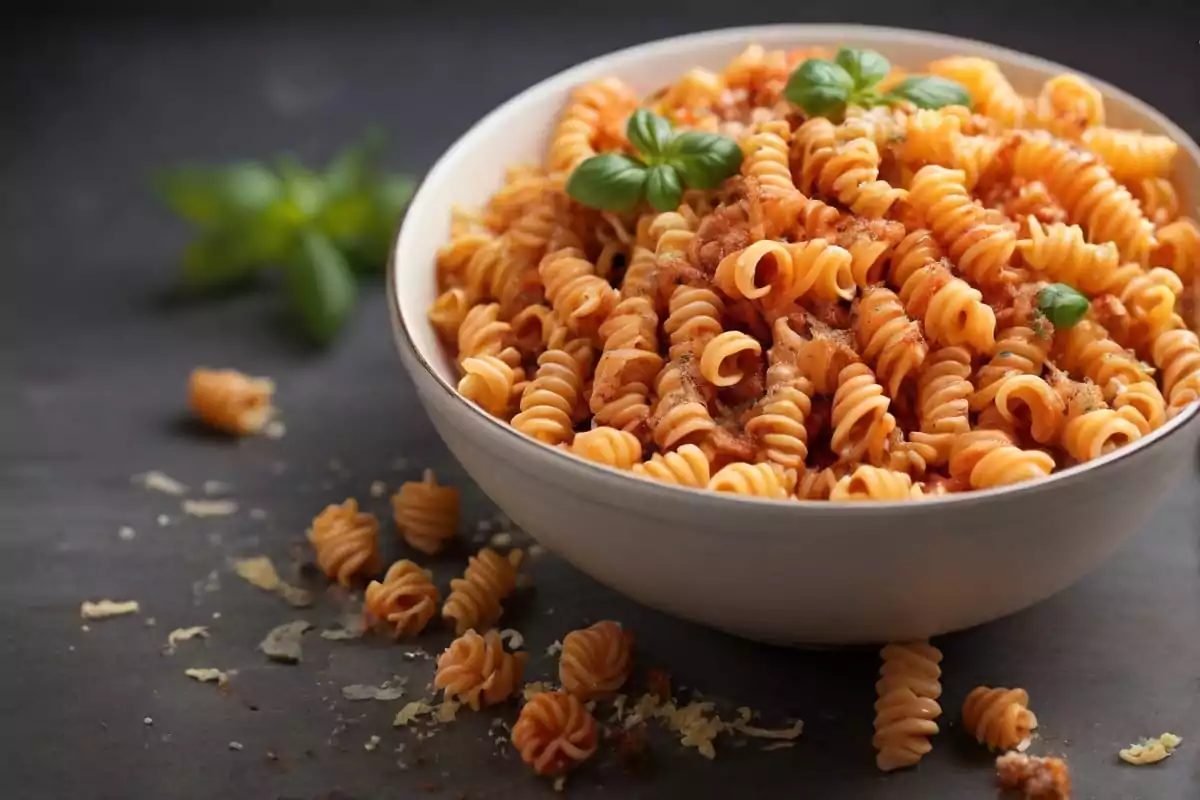Introduction to Fusilli Pasta
What Makes Fusilli Unique?
Why is fusilli pasta good, known for its corkscrew curls, is a standout in the pasta world. The name originates from “fuso,” meaning spindle, reflecting its traditional making process. This pasta shape, with its deep roots in southern Italy, has twirled its way into global cuisine. Its spirals are perfect for holding onto sauces, making every bite flavorful.
A Brief History
The story of fusilli starts in Italy, where artisans crafted it by hand. This pasta was more than food; it was an art form, showcasing Italian culinary dedication. Today, fusilli is a global staple, versatile enough for simple dinners and elaborate feasts alike.
Nutritional Profile
Fusilli isn’t just about taste; it’s nutritious too. Whole wheat versions pack a fiber-rich punch, while gluten-free options make it accessible to all. Its ability to pair with various sauces makes it a versatile choice for any diet.
Culinary Versatility
The true magic of fusilli lies in its versatility. It’s perfect for cold salads and hearty bakes, adding visual appeal and enhancing the dining experience. This pasta adapts to any dish, proving it’s more than just food—it’s a celebration of creativity and tradition.
So, why is fusilli pasta good? It embodies fun, flavor, and versatility. As we delve deeper into fusilli‘s world, you’ll see it’s not just good—it’s a cornerstone of culinary creativity. Stay tuned as we uncover more about this delightful pasta and how to incorporate it into your cooking adventures.

The Unique Qualities of Fusilli Pasta
The Shape and Texture of Fusilli
Fusilli isn’t just another pasta shape; it’s a culinary marvel. Its spirals and curls do more than just look pretty on a plate; they serve a crucial function. The twists and turns of fusilli are designed to latch onto sauces, ensuring that each forkful is as delicious as possible. This design isn’t just by chance; it’s a thoughtful feature that makes fusilli ideal for a variety of sauces, from the light and zesty to the rich and creamy.
How Fusilli Holds Sauces
The secret to fusilli‘s success with sauces lies in its surface area. The grooves and spirals provide the perfect nooks and crannies for sauces to cling to, unlike smoother pasta shapes that might let sauces slide right off. This means that with fusilli, every bite is a perfect harmony of pasta and sauce. Whether it’s a simple garlic and oil dressing or a more complex bolognese, fusilli makes sure that the flavor is evenly distributed throughout the dish.
This unique ability to hold onto sauces makes fusilli not just a pleasure to eat but also a favorite among chefs and home cooks alike. It’s the go-to pasta for dishes where sauce is the star, allowing the flavors to fully integrate with the pasta itself. Plus, its texture adds an extra layer of satisfaction to the eating experience, with the firmness of the pasta providing a delightful contrast to the smoothness of the sauce.
In the world of pasta, fusilli stands out for its design and functionality. Its shape and texture are not just for show; they enhance the overall dining experience, making every meal memorable. As we continue to explore the wonders of fusilli, it becomes clear that this pasta is a true culinary champion, versatile enough to elevate any dish it’s part of. Stay tuned as we delve deeper into the nutritional benefits of fusilli, showcasing how this delightful pasta can be a part of a balanced and delicious diet.
Nutritional Benefits
Nutritional Profile of Fusilli Pasta
Diving into the nutritional aspect, fusilli pasta is more than just a carrier for your favorite sauces—it’s a source of energy. Primarily made from durum wheat, fusilli offers a good dose of complex carbohydrates, providing the fuel your body needs to power through the day. But the benefits don’t stop there. This twisty pasta also contains protein, essential for muscle repair and growth, making it a great option for those looking to maintain a balanced diet.
Whole Wheat vs. Regular Fusilli
For health-conscious pasta lovers, the choice between whole wheat and regular fusilli can be significant. Whole wheat fusilli takes the nutritional value up a notch, offering more fiber, vitamins, and minerals than its regular counterpart. This fiber is a boon for digestive health, helping to keep things moving and improving overall gut health. Moreover, the additional nutrients found in whole wheat pasta, like magnesium, iron, and B vitamins, contribute to a well-rounded diet, supporting everything from energy levels to brain function.
Choosing whole wheat fusilli doesn’t mean sacrificing taste for health. Thanks to modern culinary advances, whole wheat pasta now boasts a much-improved texture and flavor, making it a delicious alternative to traditional pasta. It’s a win-win situation: you get all the benefits of a hearty, nutritious meal without compromising on the joy of eating a bowl of your favorite pasta.
Incorporating fusilli, especially the whole wheat variety, into your meals is a smart way to enjoy a satisfying dish that’s also good for you. Whether you’re serving it with a light vegetable sauce or a hearty meat-based ragu, fusilli offers a nutritious foundation for a multitude of recipes. Its versatility and health benefits make it a staple in the pantry of anyone looking to eat well and feel great.
As we continue to explore the culinary journey of fusilli, it’s clear that this pasta is not just about taste and texture—it’s also about nourishment. Offering a balance of energy, protein, and essential nutrients, fusilli stands out as a smart choice for anyone looking to enjoy delicious meals that are also beneficial to their health. Stay tuned as we delve into the culinary uses and versatility of fusilli, revealing how this pasta can be the star of dishes that impress both in flavor and nutritional value.

Culinary Uses and Versatility
Best Sauces and Recipes for Fusilli
Fusilli shines in a variety of dishes, thanks to its unique shape and texture. It pairs wonderfully with both light and hearty sauces. A classic pesto or a simple tomato basil sauce clings to the spirals, making every bite a burst of flavor. For something richer, a creamy Alfredo or a meaty Bolognese fills the grooves, ensuring a well-balanced mouthful. Beyond traditional Italian sauces, fusilli also works well in innovative recipes like fusilli with roasted vegetables and goat cheese or a spicy arrabbiata for those who enjoy a bit of heat.
Creative Uses in Dishes
The versatility of fusilli extends beyond pasta dishes. It’s a fantastic addition to pasta salads, where its shape holds onto dressings and complements a variety of ingredients, from cherry tomatoes and mozzarella to olives and cucumbers. Fusilli also makes an excellent base for baked pasta dishes. Layer it with cheese, vegetables, and your choice of protein, then bake until bubbly and golden for a comforting meal.
For those looking to explore the culinary potential of fusilli, consider incorporating it into soups and stews. Its sturdy structure holds up well, even in brothy or thickened liquids, adding a satisfying texture to every spoonful. Whether it’s a minestrone soup or a hearty beef stew, fusilli adds a delightful twist.
Incorporating fusilli into your cooking not only adds a playful shape to your dishes but also enhances the overall flavor profile. Its ability to pair with a wide range of ingredients and sauces makes it a pantry staple for those who love to experiment in the kitchen.
For more inspiration on how to use fusilli in your next culinary creation, check out Creative Pasta Recipes for innovative ideas and Pasta Cooking Techniques for tips on achieving the perfect texture. These resources are invaluable for both novice cooks and seasoned chefs alike, offering a wealth of knowledge on making the most out of this versatile pasta.
Cooking Tips and Tricks
Cooking Times and Techniques
Achieving the perfect fusilli starts with mastering the cooking process. The key is to boil it in plenty of salted water, giving the pasta enough space to move freely. This prevents sticking and ensures even cooking. A general rule of thumb is to cook fusilli for about 8 to 12 minutes, depending on whether you prefer it al dente or a bit softer. However, always refer to the package instructions as a guide, since cooking times can vary based on the pasta’s thickness and ingredients.
Common Mistakes to Avoid
One of the most common pitfalls in cooking fusilli is overcooking it, which can lead to a mushy texture. To avoid this, taste the pasta a few minutes before the suggested cooking time ends. Remember, it will continue to cook slightly after being drained, especially if you’re adding it to a hot sauce. Another mistake is not using enough water or forgetting to salt it. The water should taste like the sea, providing the pasta with its only chance to absorb seasoning.
Be Careful Handling the Cooked Pasta
Once fusilli is cooked, handle it with care. Draining it too aggressively can cause the delicate spirals to break. Instead, gently pour it into a colander and give it a soft shake to remove excess water. If you’re not serving it immediately, tossing it with a little olive oil can prevent sticking. This is particularly useful for pasta salads or dishes where the fusilli will sit for a while before being dressed or served.

Reserve Pasta Water
A golden tip for any pasta dish is to reserve some of the pasta water before draining. This starchy liquid is a miracle worker for sauces, helping to bind the sauce to the pasta and adjust the consistency if needed. Just a splash can transform a sauce, making it silkier and helping it cling to the fusilli more effectively.
For those eager to elevate their pasta dishes, incorporating these tips and tricks can make a world of difference. And for further guidance on perfecting your pasta technique, explore resources like Pasta Cooking Techniques for expert advice and Creative Pasta Recipes for innovative ways to use fusilli in your cooking. These insights will not only improve your pasta-making skills but also inspire you to create dishes that delight the senses.
Pairing with Ingredients
Ideal Ingredients and Flavors
Fusilli is a true culinary chameleon, adapting beautifully to a wide array of ingredients and flavors. Its spirals are perfect for capturing chunky vegetable sauces, making it an ideal partner for dishes featuring eggplant, zucchini, or bell peppers. For a protein boost, consider adding grilled chicken, pancetta, or shrimp, which complement the pasta’s texture and enhance its flavor profile. Cheese lovers will rejoice in combining fusilli with creamy feta, sharp Parmesan, or smooth ricotta, creating a delightful contrast in textures.
Seasonal Pairings
The versatility of fusilli extends to its ability to harmonize with seasonal ingredients. In the spring, toss it with fresh peas, asparagus, and a light lemon butter sauce for a refreshing meal. Summer calls for vibrant dishes featuring tomatoes, basil, and mozzarella, capturing the essence of the season. As autumn rolls in, incorporate roasted squash and sage for a heartier dish that warms the soul. Winter demands comforting meals, making fusilli with rich meat sauces or baked in a cheesy casserole the perfect choice.
This pasta’s ability to pair with a diverse range of ingredients makes it a staple in kitchens around the world. Whether you’re crafting a simple weeknight dinner or an elaborate feast, fusilli offers endless possibilities to explore. Its shape not only adds a playful twist to dishes but also ensures that every bite is loaded with flavor.
Embracing the versatility of fusilli allows for culinary creativity to flourish. Experimenting with different combinations of ingredients and flavors can lead to delightful discoveries and new favorite dishes. So, the next time you reach for a box of pasta, consider the humble fusilli and the myriad of ways it can transform your cooking.
